Financial Analysis of Benedict Company: Stakeholder & Ratio Review
VerifiedAdded on 2023/04/21
|23
|4675
|103
Report
AI Summary
This report provides a comprehensive financial analysis of Benedict Company, incorporating a stakeholder analysis of Tesco as a benchmark. It delves into various financial ratios, including liquidity ratios (current and quick ratios), long-term solvency ratios (debt-to-equity and debt-to-total assets), financial leverage ratios, and profitability ratios (gross profit, net profit, return on assets, and return on equity). Activity ratios like trade receivables, trade payables, and inventory turnover are also examined. The analysis identifies potential causes of concern within Benedict Company's financial performance and offers recommendations for improvement. The report references academic sources to support its findings and conclusions, providing a well-researched assessment of the company's financial health and stakeholder relationships.
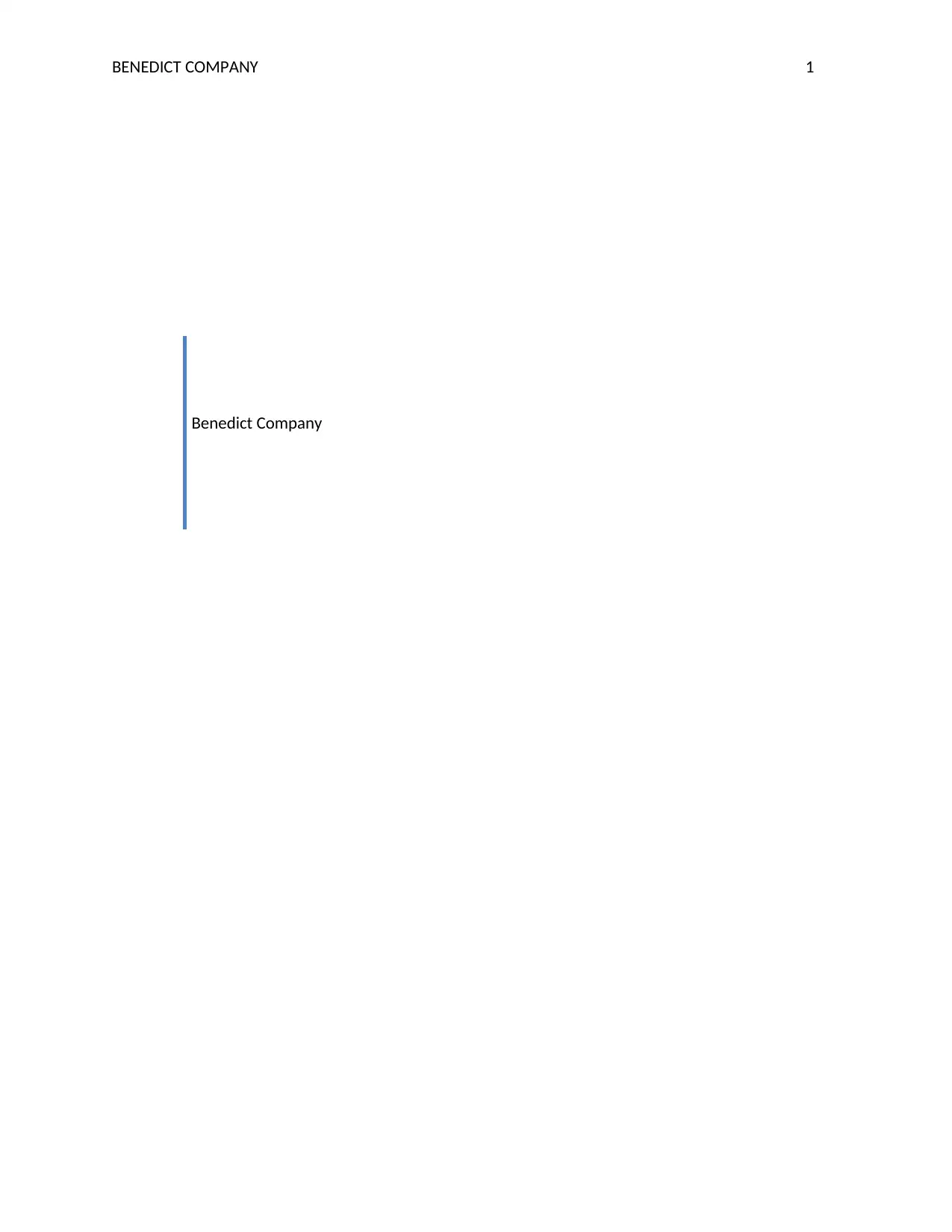
BENEDICT COMPANY 1
Benedict Company
Benedict Company
Paraphrase This Document
Need a fresh take? Get an instant paraphrase of this document with our AI Paraphraser

BENEDICT COMPANY 2
Table of Contents
Introduction......................................................................................................................................1
Stakeholder Analysis of the Tesco Company..............................................................................2
Ratio Analysis..................................................................................................................................3
Current ratio.................................................................................................................................4
Quick Ratio..................................................................................................................................5
Long Term Solvency Ratios............................................................................................................6
Debt to Equity ratio......................................................................................................................6
Debt ot total assets of the company.............................................................................................7
Financial Leverage Ratios............................................................................................................8
Profitability ratios............................................................................................................................8
Gross Profit..................................................................................................................................9
Net Profit....................................................................................................................................10
Return on Assets........................................................................................................................10
Return on Equity........................................................................................................................11
Activity Ratios...............................................................................................................................12
Trade Receivables Ratio............................................................................................................13
Trade Payable Ratio...................................................................................................................13
Inventory Turnover Ratio...........................................................................................................14
Table of Contents
Introduction......................................................................................................................................1
Stakeholder Analysis of the Tesco Company..............................................................................2
Ratio Analysis..................................................................................................................................3
Current ratio.................................................................................................................................4
Quick Ratio..................................................................................................................................5
Long Term Solvency Ratios............................................................................................................6
Debt to Equity ratio......................................................................................................................6
Debt ot total assets of the company.............................................................................................7
Financial Leverage Ratios............................................................................................................8
Profitability ratios............................................................................................................................8
Gross Profit..................................................................................................................................9
Net Profit....................................................................................................................................10
Return on Assets........................................................................................................................10
Return on Equity........................................................................................................................11
Activity Ratios...............................................................................................................................12
Trade Receivables Ratio............................................................................................................13
Trade Payable Ratio...................................................................................................................13
Inventory Turnover Ratio...........................................................................................................14
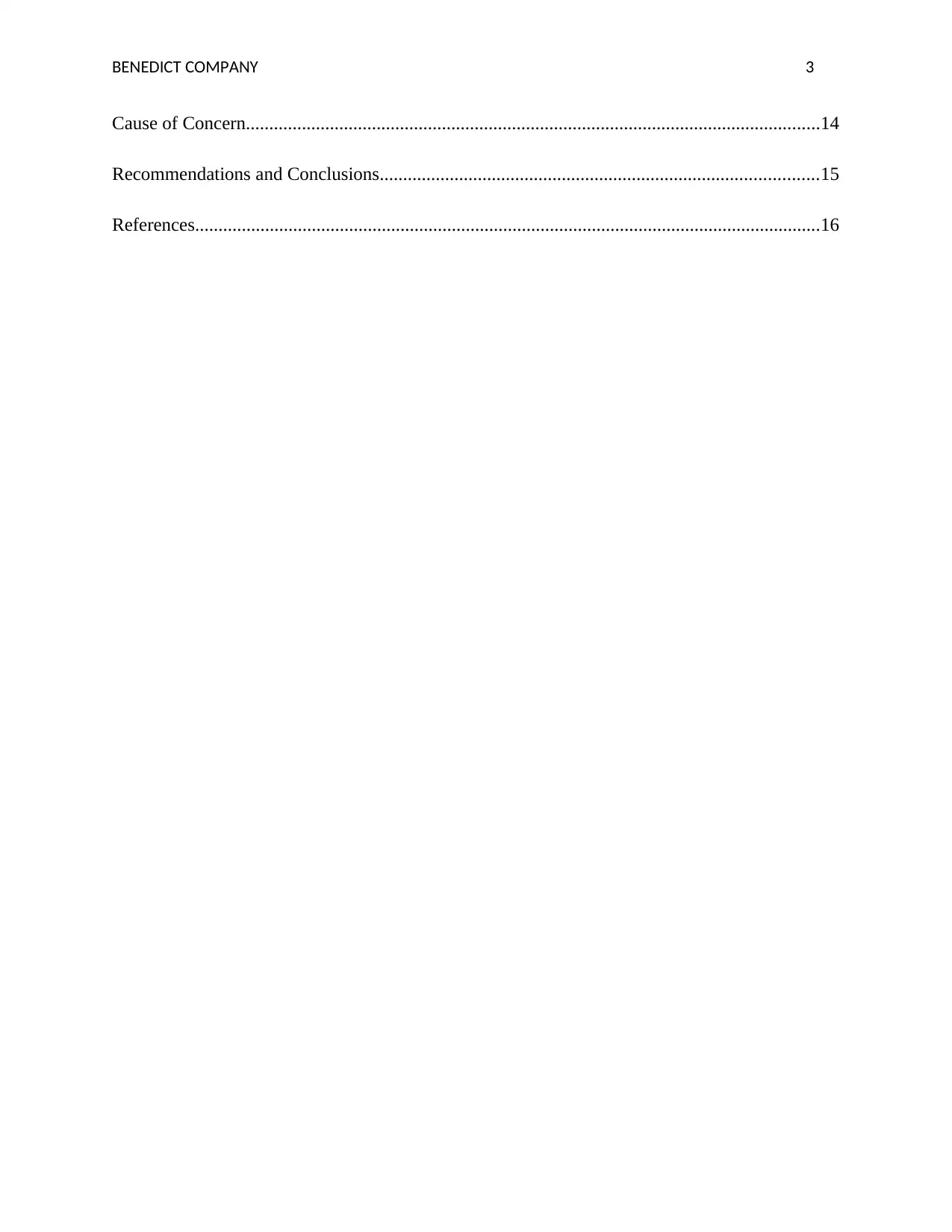
BENEDICT COMPANY 3
Cause of Concern...........................................................................................................................14
Recommendations and Conclusions..............................................................................................15
References......................................................................................................................................16
Cause of Concern...........................................................................................................................14
Recommendations and Conclusions..............................................................................................15
References......................................................................................................................................16
⊘ This is a preview!⊘
Do you want full access?
Subscribe today to unlock all pages.

Trusted by 1+ million students worldwide
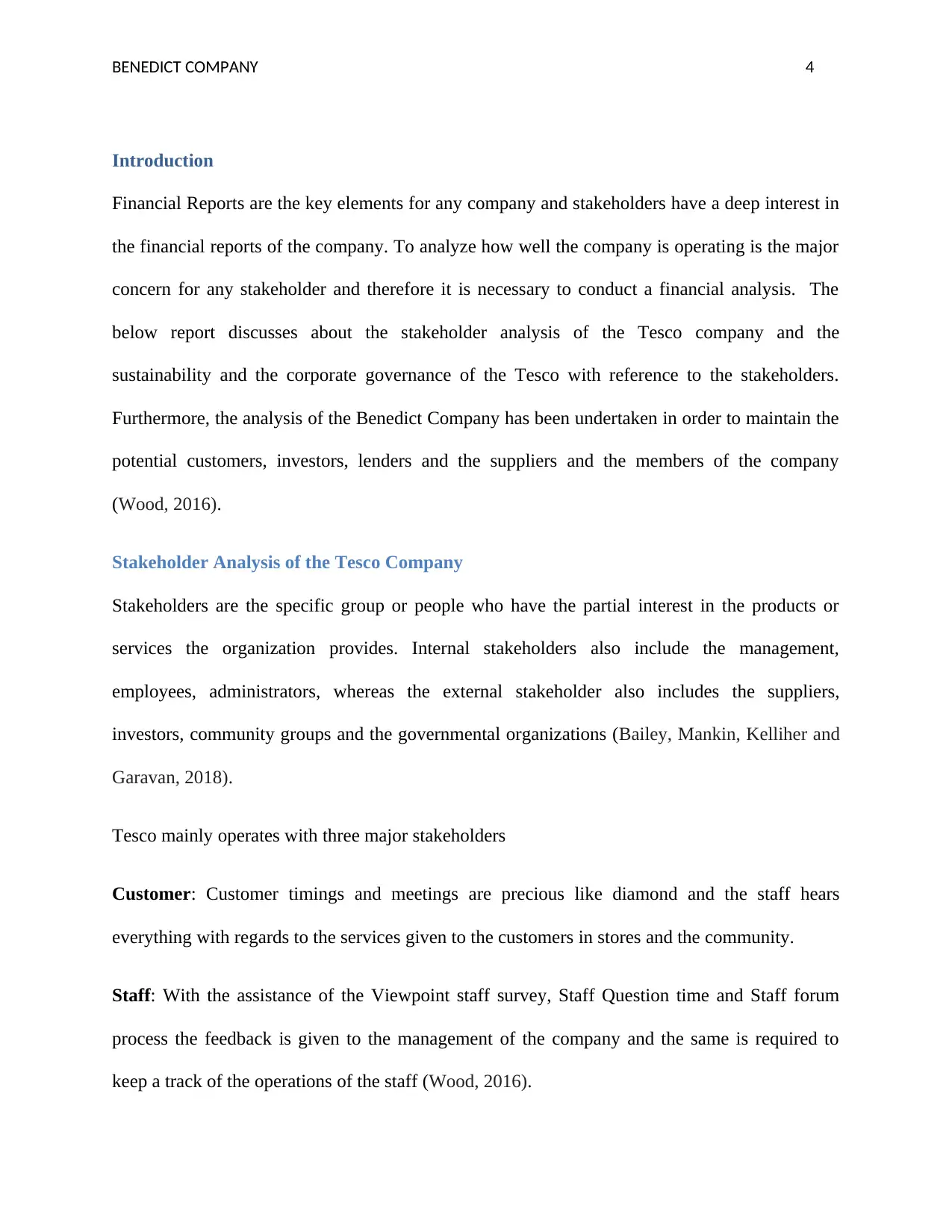
BENEDICT COMPANY 4
Introduction
Financial Reports are the key elements for any company and stakeholders have a deep interest in
the financial reports of the company. To analyze how well the company is operating is the major
concern for any stakeholder and therefore it is necessary to conduct a financial analysis. The
below report discusses about the stakeholder analysis of the Tesco company and the
sustainability and the corporate governance of the Tesco with reference to the stakeholders.
Furthermore, the analysis of the Benedict Company has been undertaken in order to maintain the
potential customers, investors, lenders and the suppliers and the members of the company
(Wood, 2016).
Stakeholder Analysis of the Tesco Company
Stakeholders are the specific group or people who have the partial interest in the products or
services the organization provides. Internal stakeholders also include the management,
employees, administrators, whereas the external stakeholder also includes the suppliers,
investors, community groups and the governmental organizations (Bailey, Mankin, Kelliher and
Garavan, 2018).
Tesco mainly operates with three major stakeholders
Customer: Customer timings and meetings are precious like diamond and the staff hears
everything with regards to the services given to the customers in stores and the community.
Staff: With the assistance of the Viewpoint staff survey, Staff Question time and Staff forum
process the feedback is given to the management of the company and the same is required to
keep a track of the operations of the staff (Wood, 2016).
Introduction
Financial Reports are the key elements for any company and stakeholders have a deep interest in
the financial reports of the company. To analyze how well the company is operating is the major
concern for any stakeholder and therefore it is necessary to conduct a financial analysis. The
below report discusses about the stakeholder analysis of the Tesco company and the
sustainability and the corporate governance of the Tesco with reference to the stakeholders.
Furthermore, the analysis of the Benedict Company has been undertaken in order to maintain the
potential customers, investors, lenders and the suppliers and the members of the company
(Wood, 2016).
Stakeholder Analysis of the Tesco Company
Stakeholders are the specific group or people who have the partial interest in the products or
services the organization provides. Internal stakeholders also include the management,
employees, administrators, whereas the external stakeholder also includes the suppliers,
investors, community groups and the governmental organizations (Bailey, Mankin, Kelliher and
Garavan, 2018).
Tesco mainly operates with three major stakeholders
Customer: Customer timings and meetings are precious like diamond and the staff hears
everything with regards to the services given to the customers in stores and the community.
Staff: With the assistance of the Viewpoint staff survey, Staff Question time and Staff forum
process the feedback is given to the management of the company and the same is required to
keep a track of the operations of the staff (Wood, 2016).
Paraphrase This Document
Need a fresh take? Get an instant paraphrase of this document with our AI Paraphraser
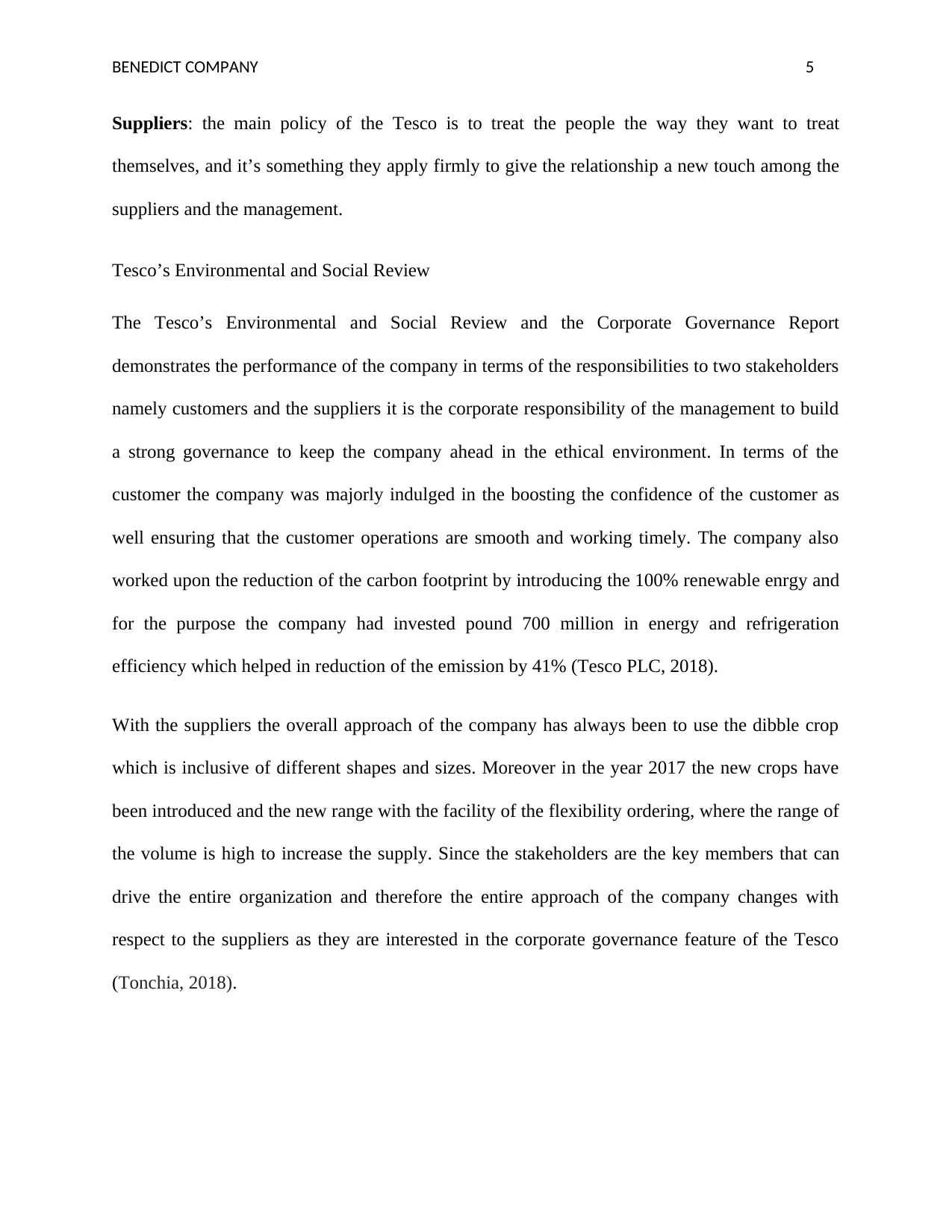
BENEDICT COMPANY 5
Suppliers: the main policy of the Tesco is to treat the people the way they want to treat
themselves, and it’s something they apply firmly to give the relationship a new touch among the
suppliers and the management.
Tesco’s Environmental and Social Review
The Tesco’s Environmental and Social Review and the Corporate Governance Report
demonstrates the performance of the company in terms of the responsibilities to two stakeholders
namely customers and the suppliers it is the corporate responsibility of the management to build
a strong governance to keep the company ahead in the ethical environment. In terms of the
customer the company was majorly indulged in the boosting the confidence of the customer as
well ensuring that the customer operations are smooth and working timely. The company also
worked upon the reduction of the carbon footprint by introducing the 100% renewable enrgy and
for the purpose the company had invested pound 700 million in energy and refrigeration
efficiency which helped in reduction of the emission by 41% (Tesco PLC, 2018).
With the suppliers the overall approach of the company has always been to use the dibble crop
which is inclusive of different shapes and sizes. Moreover in the year 2017 the new crops have
been introduced and the new range with the facility of the flexibility ordering, where the range of
the volume is high to increase the supply. Since the stakeholders are the key members that can
drive the entire organization and therefore the entire approach of the company changes with
respect to the suppliers as they are interested in the corporate governance feature of the Tesco
(Tonchia, 2018).
Suppliers: the main policy of the Tesco is to treat the people the way they want to treat
themselves, and it’s something they apply firmly to give the relationship a new touch among the
suppliers and the management.
Tesco’s Environmental and Social Review
The Tesco’s Environmental and Social Review and the Corporate Governance Report
demonstrates the performance of the company in terms of the responsibilities to two stakeholders
namely customers and the suppliers it is the corporate responsibility of the management to build
a strong governance to keep the company ahead in the ethical environment. In terms of the
customer the company was majorly indulged in the boosting the confidence of the customer as
well ensuring that the customer operations are smooth and working timely. The company also
worked upon the reduction of the carbon footprint by introducing the 100% renewable enrgy and
for the purpose the company had invested pound 700 million in energy and refrigeration
efficiency which helped in reduction of the emission by 41% (Tesco PLC, 2018).
With the suppliers the overall approach of the company has always been to use the dibble crop
which is inclusive of different shapes and sizes. Moreover in the year 2017 the new crops have
been introduced and the new range with the facility of the flexibility ordering, where the range of
the volume is high to increase the supply. Since the stakeholders are the key members that can
drive the entire organization and therefore the entire approach of the company changes with
respect to the suppliers as they are interested in the corporate governance feature of the Tesco
(Tonchia, 2018).

BENEDICT COMPANY 6
Ratio Analysis
Ratio analysis is the technique which fosters the demands of the potential investors, customers,
shareholders, suppliers and the management of the company as well. The ratios are calculated
keeping an idea of measuring the financial performance of the company in terms of the liquidity,
efficiency and the profitability of the business. The ratios are the key determinants that can be
sued to compare the inter as well the intra industry and company comparison to find out the
position of the company and the place at which it stands in terms of the competitors. Ratio
analysis helps in making aware about the variances to the company.
The first ratio that shall be selected by the company are Liquidity ratios, which are used to
measure the financial position of the business in terms of how liquid the company can become to
meet its current obligations on time. The company shall have sufficient amount to pay back the
current liabilities efficiently and effectively. The liquidity ratios are further segregated into the
current ratio, quick ratio (Kowalik, 2018).
Current ratio
Current Ratio is the ratio calculated to find out the ability of the company to payback its current
liabilities on the virtue of the current assets. The current ratio is ideally 2:1 however the current
ratio differs as the sector differs. Moreover as it can be observed from the table and the graph
below and in comparison to the industry as well the current ratio of the Benedict Company is
1.19 which has been reduced from 1.25 whereas in comparison to the industry benchmark the
company is performing better than the industry in this ratio (Arora and Kohli, 2018).
Therefore it can be concluded that the current ratio is better yet has some ore room for the
improvement and to improve the ratio the useless assets shall be eradicated from the company,
Ratio Analysis
Ratio analysis is the technique which fosters the demands of the potential investors, customers,
shareholders, suppliers and the management of the company as well. The ratios are calculated
keeping an idea of measuring the financial performance of the company in terms of the liquidity,
efficiency and the profitability of the business. The ratios are the key determinants that can be
sued to compare the inter as well the intra industry and company comparison to find out the
position of the company and the place at which it stands in terms of the competitors. Ratio
analysis helps in making aware about the variances to the company.
The first ratio that shall be selected by the company are Liquidity ratios, which are used to
measure the financial position of the business in terms of how liquid the company can become to
meet its current obligations on time. The company shall have sufficient amount to pay back the
current liabilities efficiently and effectively. The liquidity ratios are further segregated into the
current ratio, quick ratio (Kowalik, 2018).
Current ratio
Current Ratio is the ratio calculated to find out the ability of the company to payback its current
liabilities on the virtue of the current assets. The current ratio is ideally 2:1 however the current
ratio differs as the sector differs. Moreover as it can be observed from the table and the graph
below and in comparison to the industry as well the current ratio of the Benedict Company is
1.19 which has been reduced from 1.25 whereas in comparison to the industry benchmark the
company is performing better than the industry in this ratio (Arora and Kohli, 2018).
Therefore it can be concluded that the current ratio is better yet has some ore room for the
improvement and to improve the ratio the useless assets shall be eradicated from the company,
⊘ This is a preview!⊘
Do you want full access?
Subscribe today to unlock all pages.

Trusted by 1+ million students worldwide
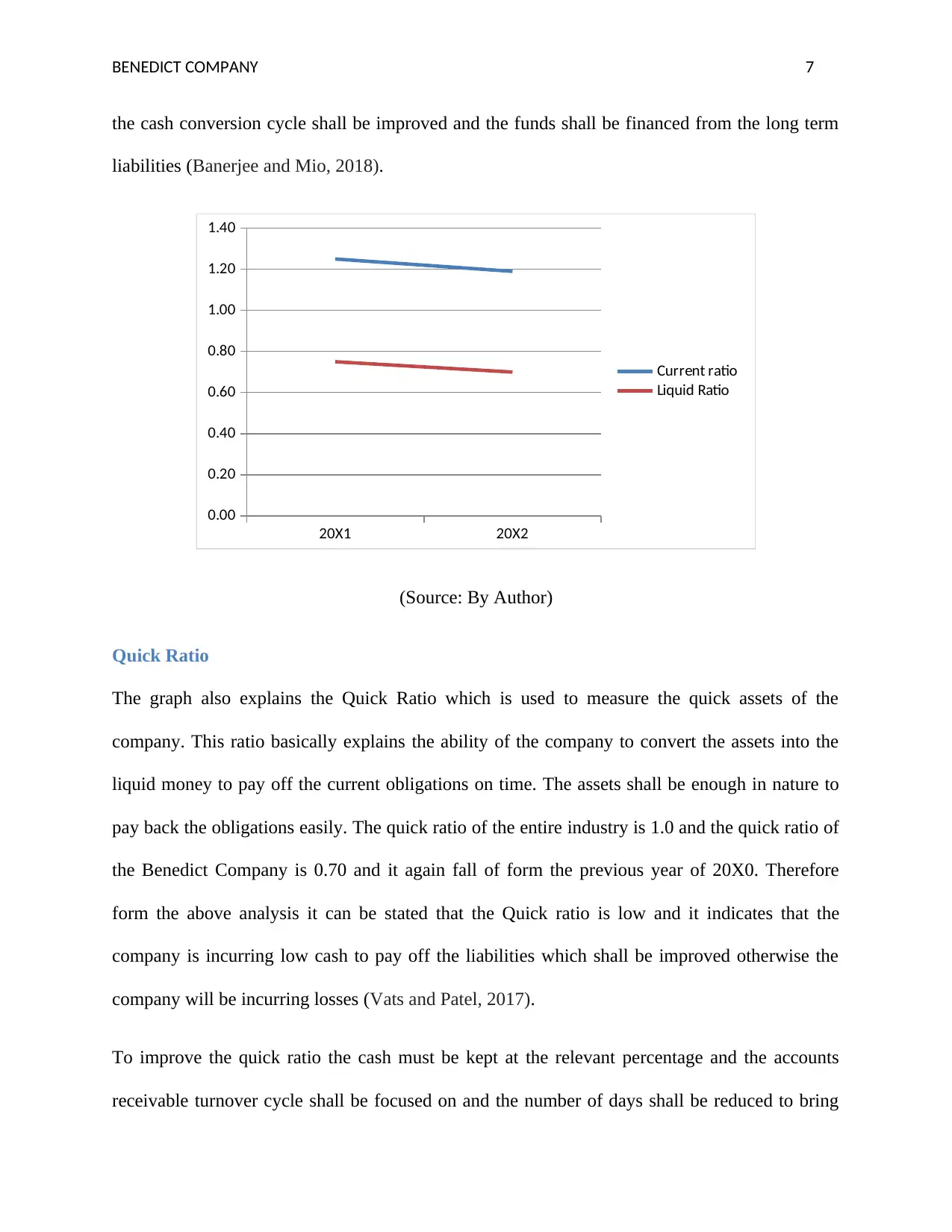
BENEDICT COMPANY 7
the cash conversion cycle shall be improved and the funds shall be financed from the long term
liabilities (Banerjee and Mio, 2018).
20X1 20X2
0.00
0.20
0.40
0.60
0.80
1.00
1.20
1.40
Current ratio
Liquid Ratio
(Source: By Author)
Quick Ratio
The graph also explains the Quick Ratio which is used to measure the quick assets of the
company. This ratio basically explains the ability of the company to convert the assets into the
liquid money to pay off the current obligations on time. The assets shall be enough in nature to
pay back the obligations easily. The quick ratio of the entire industry is 1.0 and the quick ratio of
the Benedict Company is 0.70 and it again fall of form the previous year of 20X0. Therefore
form the above analysis it can be stated that the Quick ratio is low and it indicates that the
company is incurring low cash to pay off the liabilities which shall be improved otherwise the
company will be incurring losses (Vats and Patel, 2017).
To improve the quick ratio the cash must be kept at the relevant percentage and the accounts
receivable turnover cycle shall be focused on and the number of days shall be reduced to bring
the cash conversion cycle shall be improved and the funds shall be financed from the long term
liabilities (Banerjee and Mio, 2018).
20X1 20X2
0.00
0.20
0.40
0.60
0.80
1.00
1.20
1.40
Current ratio
Liquid Ratio
(Source: By Author)
Quick Ratio
The graph also explains the Quick Ratio which is used to measure the quick assets of the
company. This ratio basically explains the ability of the company to convert the assets into the
liquid money to pay off the current obligations on time. The assets shall be enough in nature to
pay back the obligations easily. The quick ratio of the entire industry is 1.0 and the quick ratio of
the Benedict Company is 0.70 and it again fall of form the previous year of 20X0. Therefore
form the above analysis it can be stated that the Quick ratio is low and it indicates that the
company is incurring low cash to pay off the liabilities which shall be improved otherwise the
company will be incurring losses (Vats and Patel, 2017).
To improve the quick ratio the cash must be kept at the relevant percentage and the accounts
receivable turnover cycle shall be focused on and the number of days shall be reduced to bring
Paraphrase This Document
Need a fresh take? Get an instant paraphrase of this document with our AI Paraphraser
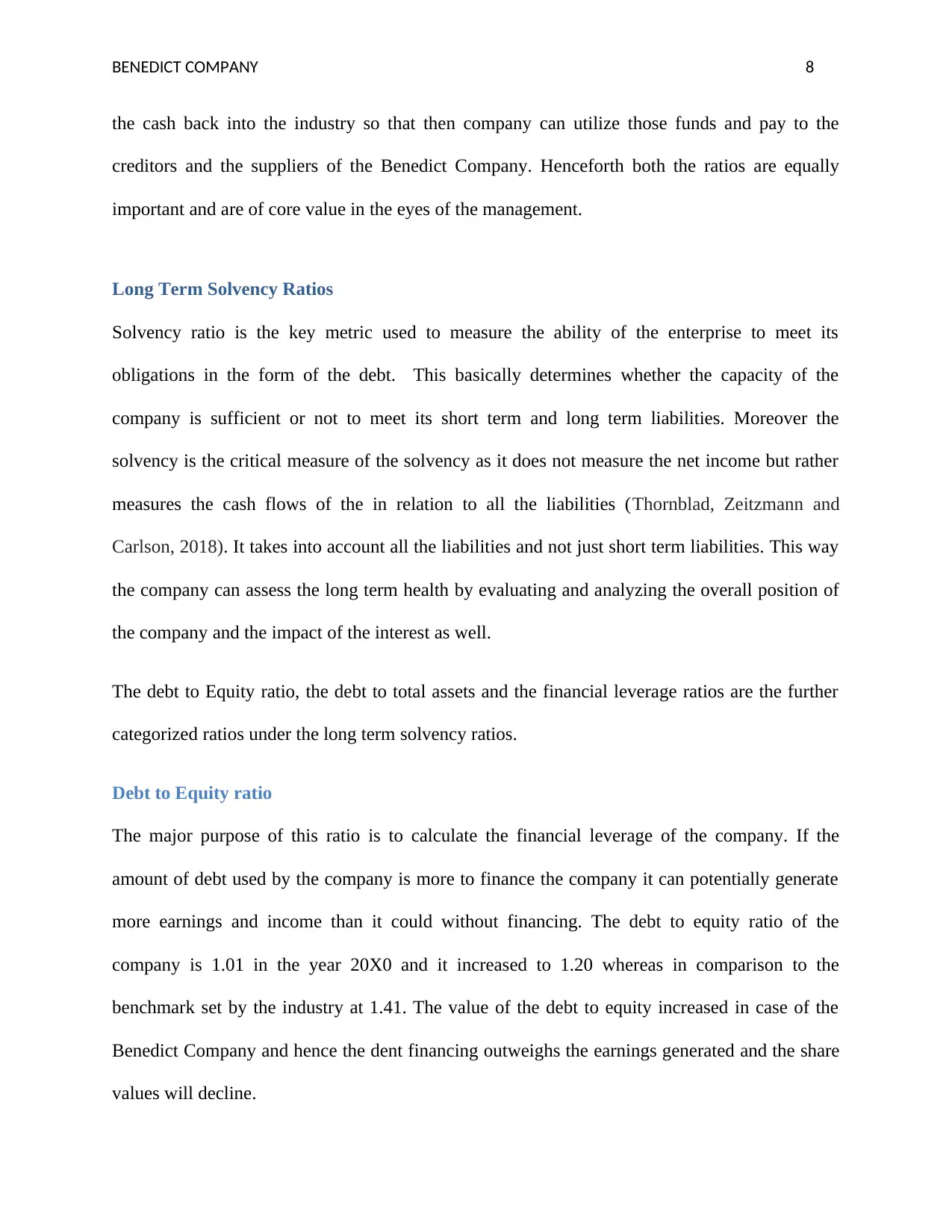
BENEDICT COMPANY 8
the cash back into the industry so that then company can utilize those funds and pay to the
creditors and the suppliers of the Benedict Company. Henceforth both the ratios are equally
important and are of core value in the eyes of the management.
Long Term Solvency Ratios
Solvency ratio is the key metric used to measure the ability of the enterprise to meet its
obligations in the form of the debt. This basically determines whether the capacity of the
company is sufficient or not to meet its short term and long term liabilities. Moreover the
solvency is the critical measure of the solvency as it does not measure the net income but rather
measures the cash flows of the in relation to all the liabilities (Thornblad, Zeitzmann and
Carlson, 2018). It takes into account all the liabilities and not just short term liabilities. This way
the company can assess the long term health by evaluating and analyzing the overall position of
the company and the impact of the interest as well.
The debt to Equity ratio, the debt to total assets and the financial leverage ratios are the further
categorized ratios under the long term solvency ratios.
Debt to Equity ratio
The major purpose of this ratio is to calculate the financial leverage of the company. If the
amount of debt used by the company is more to finance the company it can potentially generate
more earnings and income than it could without financing. The debt to equity ratio of the
company is 1.01 in the year 20X0 and it increased to 1.20 whereas in comparison to the
benchmark set by the industry at 1.41. The value of the debt to equity increased in case of the
Benedict Company and hence the dent financing outweighs the earnings generated and the share
values will decline.
the cash back into the industry so that then company can utilize those funds and pay to the
creditors and the suppliers of the Benedict Company. Henceforth both the ratios are equally
important and are of core value in the eyes of the management.
Long Term Solvency Ratios
Solvency ratio is the key metric used to measure the ability of the enterprise to meet its
obligations in the form of the debt. This basically determines whether the capacity of the
company is sufficient or not to meet its short term and long term liabilities. Moreover the
solvency is the critical measure of the solvency as it does not measure the net income but rather
measures the cash flows of the in relation to all the liabilities (Thornblad, Zeitzmann and
Carlson, 2018). It takes into account all the liabilities and not just short term liabilities. This way
the company can assess the long term health by evaluating and analyzing the overall position of
the company and the impact of the interest as well.
The debt to Equity ratio, the debt to total assets and the financial leverage ratios are the further
categorized ratios under the long term solvency ratios.
Debt to Equity ratio
The major purpose of this ratio is to calculate the financial leverage of the company. If the
amount of debt used by the company is more to finance the company it can potentially generate
more earnings and income than it could without financing. The debt to equity ratio of the
company is 1.01 in the year 20X0 and it increased to 1.20 whereas in comparison to the
benchmark set by the industry at 1.41. The value of the debt to equity increased in case of the
Benedict Company and hence the dent financing outweighs the earnings generated and the share
values will decline.

BENEDICT COMPANY 9
⊘ This is a preview!⊘
Do you want full access?
Subscribe today to unlock all pages.

Trusted by 1+ million students worldwide
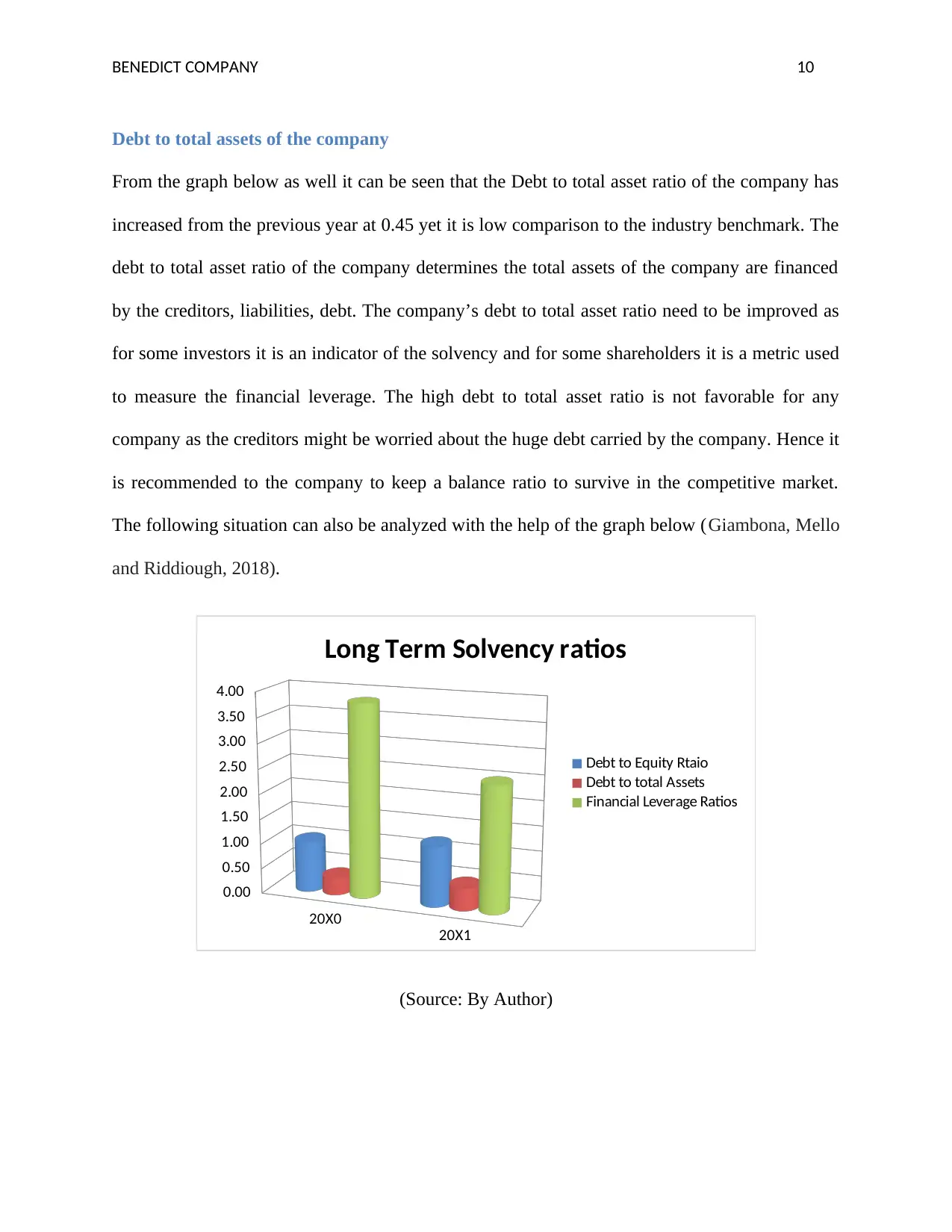
BENEDICT COMPANY 10
Debt to total assets of the company
From the graph below as well it can be seen that the Debt to total asset ratio of the company has
increased from the previous year at 0.45 yet it is low comparison to the industry benchmark. The
debt to total asset ratio of the company determines the total assets of the company are financed
by the creditors, liabilities, debt. The company’s debt to total asset ratio need to be improved as
for some investors it is an indicator of the solvency and for some shareholders it is a metric used
to measure the financial leverage. The high debt to total asset ratio is not favorable for any
company as the creditors might be worried about the huge debt carried by the company. Hence it
is recommended to the company to keep a balance ratio to survive in the competitive market.
The following situation can also be analyzed with the help of the graph below (Giambona, Mello
and Riddiough, 2018).
20X0
20X1
0.00
0.50
1.00
1.50
2.00
2.50
3.00
3.50
4.00
Long Term Solvency ratios
Debt to Equity Rtaio
Debt to total Assets
Financial Leverage Ratios
(Source: By Author)
Debt to total assets of the company
From the graph below as well it can be seen that the Debt to total asset ratio of the company has
increased from the previous year at 0.45 yet it is low comparison to the industry benchmark. The
debt to total asset ratio of the company determines the total assets of the company are financed
by the creditors, liabilities, debt. The company’s debt to total asset ratio need to be improved as
for some investors it is an indicator of the solvency and for some shareholders it is a metric used
to measure the financial leverage. The high debt to total asset ratio is not favorable for any
company as the creditors might be worried about the huge debt carried by the company. Hence it
is recommended to the company to keep a balance ratio to survive in the competitive market.
The following situation can also be analyzed with the help of the graph below (Giambona, Mello
and Riddiough, 2018).
20X0
20X1
0.00
0.50
1.00
1.50
2.00
2.50
3.00
3.50
4.00
Long Term Solvency ratios
Debt to Equity Rtaio
Debt to total Assets
Financial Leverage Ratios
(Source: By Author)
Paraphrase This Document
Need a fresh take? Get an instant paraphrase of this document with our AI Paraphraser

BENEDICT COMPANY 11
Financial Leverage Ratios
The financial leverage ratios of the company are the ratios which represents the financial
performance of the company. Financial leverage ratios mainly measure the equity value in a
company by making an evaluation of the debt in overall sense. The main aim of the financial
leverage ratios is to show that how much of the assets of the company are belonging to the
shareholders rather than they belong to the creditors (Barbiero Popov and Wolski, 2018). Form
the above graph it can be observed that the average total assets of the company when divided by
the average equity have decreased as the assets have not been utilized by the company in the
most critical value. The ratio increased from 1.08 to 2.49 and hence the company needs to value
the performance of the company.
Profitability ratios
Profitability ratios of the company are the ones that are calculated to determine whether the
company is operating profitably or not. Profitability ratios are also important form the point of
view of the investors and the shareholders as most of the earnings are the key drivers for the
shareholders (Ponikvar, Kejžar and Peljhan, 2018). The profitability is the most important factor
in terms of the inter as well intra company comparison so that it gives the idea to the
management about whether the company shall improve the performance of the company, or
whether it is operating well or not or suffering from losses that needs to be recovered (Laitinen
and Laitinen, 2018).
Gross Profit
The gross profit ratio is the ratio which the company makes after the deduction of the costs
incurred by the company to bring the product into the saleable condition. It is basically the
Financial Leverage Ratios
The financial leverage ratios of the company are the ratios which represents the financial
performance of the company. Financial leverage ratios mainly measure the equity value in a
company by making an evaluation of the debt in overall sense. The main aim of the financial
leverage ratios is to show that how much of the assets of the company are belonging to the
shareholders rather than they belong to the creditors (Barbiero Popov and Wolski, 2018). Form
the above graph it can be observed that the average total assets of the company when divided by
the average equity have decreased as the assets have not been utilized by the company in the
most critical value. The ratio increased from 1.08 to 2.49 and hence the company needs to value
the performance of the company.
Profitability ratios
Profitability ratios of the company are the ones that are calculated to determine whether the
company is operating profitably or not. Profitability ratios are also important form the point of
view of the investors and the shareholders as most of the earnings are the key drivers for the
shareholders (Ponikvar, Kejžar and Peljhan, 2018). The profitability is the most important factor
in terms of the inter as well intra company comparison so that it gives the idea to the
management about whether the company shall improve the performance of the company, or
whether it is operating well or not or suffering from losses that needs to be recovered (Laitinen
and Laitinen, 2018).
Gross Profit
The gross profit ratio is the ratio which the company makes after the deduction of the costs
incurred by the company to bring the product into the saleable condition. It is basically the
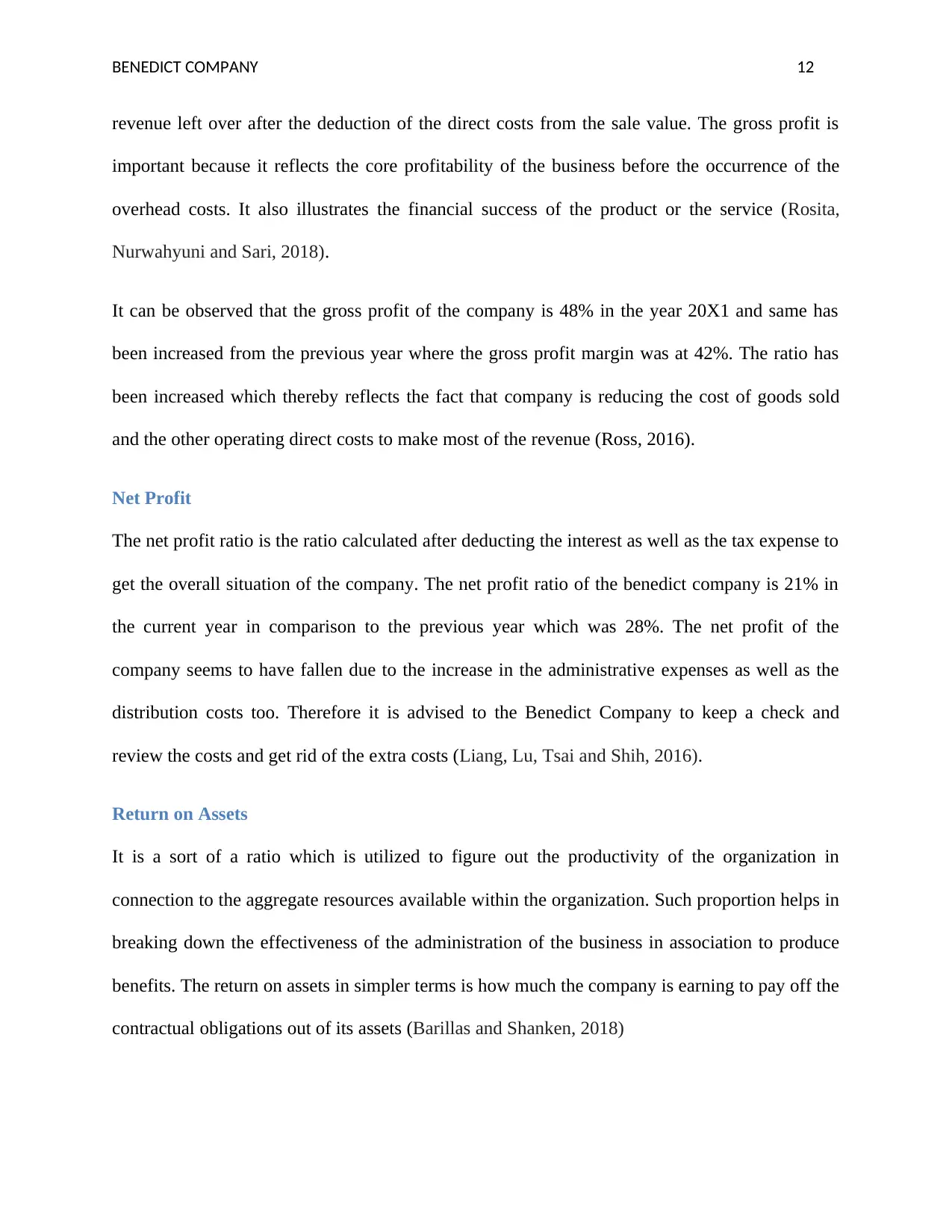
BENEDICT COMPANY 12
revenue left over after the deduction of the direct costs from the sale value. The gross profit is
important because it reflects the core profitability of the business before the occurrence of the
overhead costs. It also illustrates the financial success of the product or the service (Rosita,
Nurwahyuni and Sari, 2018).
It can be observed that the gross profit of the company is 48% in the year 20X1 and same has
been increased from the previous year where the gross profit margin was at 42%. The ratio has
been increased which thereby reflects the fact that company is reducing the cost of goods sold
and the other operating direct costs to make most of the revenue (Ross, 2016).
Net Profit
The net profit ratio is the ratio calculated after deducting the interest as well as the tax expense to
get the overall situation of the company. The net profit ratio of the benedict company is 21% in
the current year in comparison to the previous year which was 28%. The net profit of the
company seems to have fallen due to the increase in the administrative expenses as well as the
distribution costs too. Therefore it is advised to the Benedict Company to keep a check and
review the costs and get rid of the extra costs (Liang, Lu, Tsai and Shih, 2016).
Return on Assets
It is a sort of a ratio which is utilized to figure out the productivity of the organization in
connection to the aggregate resources available within the organization. Such proportion helps in
breaking down the effectiveness of the administration of the business in association to produce
benefits. The return on assets in simpler terms is how much the company is earning to pay off the
contractual obligations out of its assets (Barillas and Shanken, 2018)
revenue left over after the deduction of the direct costs from the sale value. The gross profit is
important because it reflects the core profitability of the business before the occurrence of the
overhead costs. It also illustrates the financial success of the product or the service (Rosita,
Nurwahyuni and Sari, 2018).
It can be observed that the gross profit of the company is 48% in the year 20X1 and same has
been increased from the previous year where the gross profit margin was at 42%. The ratio has
been increased which thereby reflects the fact that company is reducing the cost of goods sold
and the other operating direct costs to make most of the revenue (Ross, 2016).
Net Profit
The net profit ratio is the ratio calculated after deducting the interest as well as the tax expense to
get the overall situation of the company. The net profit ratio of the benedict company is 21% in
the current year in comparison to the previous year which was 28%. The net profit of the
company seems to have fallen due to the increase in the administrative expenses as well as the
distribution costs too. Therefore it is advised to the Benedict Company to keep a check and
review the costs and get rid of the extra costs (Liang, Lu, Tsai and Shih, 2016).
Return on Assets
It is a sort of a ratio which is utilized to figure out the productivity of the organization in
connection to the aggregate resources available within the organization. Such proportion helps in
breaking down the effectiveness of the administration of the business in association to produce
benefits. The return on assets in simpler terms is how much the company is earning to pay off the
contractual obligations out of its assets (Barillas and Shanken, 2018)
⊘ This is a preview!⊘
Do you want full access?
Subscribe today to unlock all pages.

Trusted by 1+ million students worldwide
1 out of 23
Related Documents
Your All-in-One AI-Powered Toolkit for Academic Success.
+13062052269
info@desklib.com
Available 24*7 on WhatsApp / Email
![[object Object]](/_next/static/media/star-bottom.7253800d.svg)
Unlock your academic potential
Copyright © 2020–2025 A2Z Services. All Rights Reserved. Developed and managed by ZUCOL.




